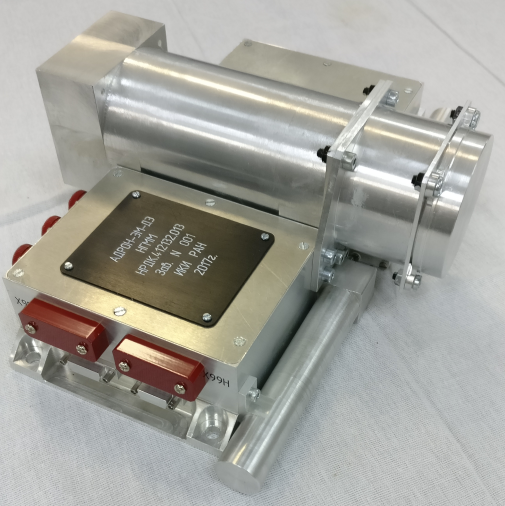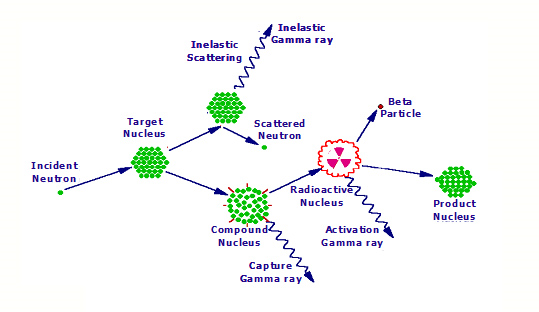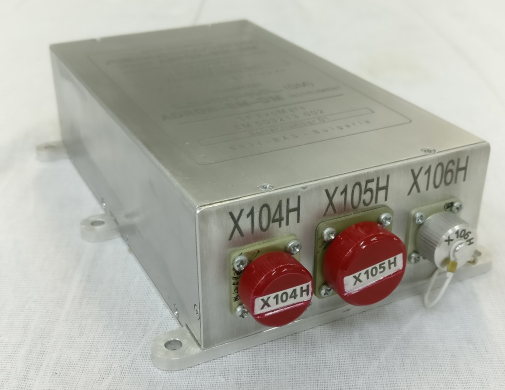Gamma-ray and neutron spectrometer and dosimeter ADRON-EM
-------------------------------------------------------------------------------------------------------------------------------------------------
-------------------------------------------------------------------------------------------------------------------------------------------------

ADRON-EM is intended for physical measurements of neutron fluxes and gamma rays on the surface of Mars and for monitoring the radiation situation at the landing site. ADRON-EM is supposed to provide measurements of physical values on the surface of Mars in accordance with the table:
| Physical values | Measured characteristics | Measuring block |
| Thermal and epithermal neutrons fluxes | Neutron counting rate in the energy range of 0.025 eV to 1.0 KeV | STN detector |
| Epithermal neutrons flux | Neutron counting rate in the energy range of 0.4 eV to 1.0 KeV | SETN detector |
| Gamma-ray spectrum | Gamma-ray spectrum in the energy range of 200 KeV to 7 MeV with energy resolution of not more than 4.5% at the line of 662 KeV 137Cs | GRS detector |
| Absorbed dose rate | Range of measurements from 10-6 to 1 Gy/h; time resolution for the dose is 1 min | Dosimeter |
| Density of the charged particles flux | Range of measurements from 0.1 to 50000 particles/(cm2/s); time resolution for the flux is 1 min | Dosimeter |
| LET spectrum (Si) | Resolution not more than 100 keV in the range of 60 keV to 17 MeV and not more than 1 MeV in the range of 17.1 MeV to 180 MeV; time resolution for LET spectra: 1 hr | Dosimeter |
| LET spectrum(H2O) | Measurements range from 0.1 to 320 keV/µm; time resolution for LET spectra: 1 hr | Dosimeter |
- Search for and determination of water content bound in the composition of the subsurface soil of Mars to a depth of 0.5-1.0 m;
- Determination of the elemental composition of the subsurface soil to a depth of 0.5 m;
- Investigation of the physical properties of the surface soil (layered structure, density, temperature effects);
- Complex measurements with the help of the ADRON-EM instrument and the ADRON-RM instrument installed on the mobile platform for joint research of soil properties near the landing site (measurements of the attenuation of the neutron signal from the pulsed neutron generator as the rover moves away from the landing platform);
- Long-term monitoring of the radiation situation in quiet sun and during solar proton events;
- Long-term monitoring of seasonal changes (variations in seasonal water content, temperature effects in the soil);
- Joint physical calibrations and measurements with other scientific instruments.
The ADRON-EM equipment is designed to conduct active pulsed neutron probing of the surface layer of the Martian soil in the area of the landing of the ExoMars 2020 project. The main goal of the ADRON-EM scientific experiment is to determine the elemental composition based on measurements of secondary neutron and gamma radiation.
The degree of novelty of the experiment
To register gamma radiation in the ADRON-EM instrument, a new type of scintillation detector based on the CeBr3 crystal is used. This detector has a higher spectral resolution (about 4% at the energy of 662 keV) compared to other scintillation detectors, and is the optimal choice between simplicity of implementation, presentation of minimal requirements for hardware resources (same as for standard scintillation detectors), and very high energy resolution achieved using semiconductor detectors based on high-purity germanium (which require large resources in terms of mass, consumption and thermal conditions, while having a small operational life).
The use of a vacuum pulsed neutron generator (a unique instrument developed at VNIIA named after N.L. Dukhov specifically for research on the surface of Mars) allows the generation of ultrashort (2-3 μs) pulses of fast neutrons. Measurement of neutron and gamma radiation in different time windows (in the range of 10-10000 μs) after a neutron pulse with a high time resolution (in microseconds) allows you to detect the soil structure (to a depth of 50 cm), separate gamma lines of inelastic scattering and capture, obtain additional gamma lines from induced gamma radiation, make it possible to optimally select time windows where the background contribution from the spacecraft is minimal.
Scientific equipment (SE) ADRON-EM is designed to work in active and passive modes. In the active mode, the neutron generator block emits intense neutron pulses with energies of 14 MeV. Each pulse with a duration of up to 2 μs, emits about 107 neutrons. These neutrons are emitted isotropically, and some of them penetrate the Martian soil (directly under the landing platform) to a depth of about 1 meter. In the passive measurement mode, fast neutrons have a natural origin, forming at a depth of about 1-2 m because of the interaction of high-energy charged particles of galactic rays (they can penetrate the thin atmosphere of Mars and bombard its surface) with the nuclei of rock-forming elements.
Neutrons interact with the nuclei of the substance through inelastic scattering and capture reactions, in which the nucleus first goes into an excited state, and then into the ground state with the emission of a gamma quantum with a certain energy. In addition, in the process of irradiating the soil with fast neutrons from the ADRON-PNG block, short-lived isotopes are formed which also decay with the emission of a gamma quantum with a characteristic energy (Figure 1).

Fig. 1.The scheme of interaction of neutrons with nuclei of isotopes with the formation of characteristic gamma rays
As a result, a gamma radiation spectrum is formed with a certain set of gamma lines corresponding to the elemental composition of the near-the-surface soil layer. Registration of such a gamma spectrum using the ADRON-GD module will allow us to determine the elemental composition of Martian soil.
In the process of interaction with the nuclei of the substance, fast neutrons lose their energy and can also return to the surface with energies corresponding to the epithermal En = [0.4 eV –1.0 keV] and thermal [En < 0.4 eV] ranges. The ADRON-DN module with high time resolution effectively detects these neutrons. The shape and amplitude of the time response recorded by the neutron detectors of the ADRON-DN module when working together with the ADRON-PNG module (within 1 ms after the neutron pulse) strongly depends on the content and distribution of hydrogen (usually in the composition of water or hydrated minerals). In addition, variations in the density and temperature of the soil and the presence of absorbing elements (such as, for example, chlorine and iron) influence the shape of the curve. Together, these dependencies can be used to determine the distribution of water in the upper layer of the substance and determine physical characteristics of the soil.
The ADRON-EM instrument consists of three blocks: ADRON-EM-DE (block of detectors and electronics), ADRON-EM-PNG (pulsed neutron generator) and ADRON-EM-DM (dosimeter). After turning on the power and completing the initialization mode, ADRON-EM is in standby mode, collecting only service information and storing it in its internal memory. Later on, the accumulated information after the survey is transmitted via the telemetric interface to the BIM. Modes and operation duration of the instrument change in compliance with the commands according to the cyclogram of the instrument on the spacecraft.
The composition of the scientific equipment with a description of nodes of the instrument and tasks performed by ADRON-EM is presented in the Table
Table 1
| Block or module name | Designation |
| Pulsed neutron generator block ADRON-PNG |
ADRON-PNG is a separate element designed for the generation of ultrashort (duration is 2-3 ms) neutron pulses with the energy of 14 MeV for irradiation of the surface substance. This block is also supposed to be used in the joint operation of the ADRON-EM instrument and instruments installed on the rover (ADRON and WISDOM) |
| Neutron detector module ADRON-DN | ADRON-DN is intended for registration of epithermal and thermal neutron fluxes in active mode (joint work with the ADRON-PNG unit) and in passive mode (registration of natural neutron background) |
| Gamma-ray detector module ADRON-GD | ADRON-GD is intended for recording and spectral analysis of the gamma-ray flux under conditions of active work with a neutron generator and in conditions of passive measurements of the natural background of gamma radiation. |
| Electronics module ADRON-ME | ADRON-ME is designed to generate secondary power for all modules of the scientific equipment, to control its operation, to process and transmit onboard the data of official and scientific telemetry. |
| Dosimeter block ADRON-DM | ADRON-DM is intended for monitoring the radiation situation (determination of the radiation dose by charged particles) |
The ADRON-DN, ADRON-GD and ADRON-ME modules are structurally combined into one ADRON-DE detector and electronics unit, which is connected to the ADRON-PNG and ADRON-DM blocks via interconnecting cables.

Fig. 2.External view of ADRON-EM-DE

Fig. 3.External view of Liulin-ML

Fig. 4.External view of PNG-10M
| Mass : | <2,5 kg - ADRON-EM-DE <2,7 kg - ADRON-EM-PNG <0,55 kg - ADRON-EM-DM |
| Consumption : | Not more than 7 W - DE Not more than 14 W - PNG Not more than 3,5 W - DM |
| Dimensions : | 269 x 200 x 86 mm - DE 340 x 125 x 45 mm - PNG 174 x 114 x 46 mm - DM |
According to the data obtained using detectors of the DE block, the following parameters of the Martian soil and the environment will be determined:
- Neutron component of the natural radiation background (absolute neutron flux density) with a relative accuracy of 10%;
- Average water content at a depth of up to 50 cm with an accuracy of 0.1%;
- Elemental composition of the subsurface soil layer (main rock-forming and rare elements H, Si, O, Al, Fe, K, U, Th, Cl, Mg, Mn, Ca, Na) with a relative error of 1-20%;
- Distribution of water and the substance composition to a depth of 50 cm, an interval of 10 cm; soil density with a relative error of 10%;
- Daily and seasonal variations of the neutron flux (due to temperature variations and variations in water content) with a relative accuracy of better than 1%.
The main functional features of ADRON-EM-PNG include pulsed generation of neutrons with an energy of 14 MeV both in the single-pulse mode and with a frequency of up to 10 Hz. The number of neutrons per pulse should be at least 107 neutrons, and the total number of emitted pulses during the operation (during the year on the surface of Mars) should be at least 107.
The detection module of the Liulin-ML dosimeter is a system of 2 telescopes containing two semiconductor detectors each. The axes of the telescopes are mutually perpendicular. The detector system of the dosimeter unit has the following characteristics:
- Type of detector - silicon based semiconductor;
- Sensitive area - 2 cm2;
- Number of detectors - 4.
Switching on and off of Liulin-ML is carried out through the DE unit. Current information on the dose rate, particle flux density, and LET spectrum is accumulated in the Liulin-ML microcontroller with its periodic transmission to the DE unit for subsequent transmission to the Earth. Information on the flight time and issuing of the control actions of the ExoMars-2020 spacecraft to the Liulin-ML block are also transmitted through the DE block.
The service life of ADRON-EM must be at least 7 years, of which:
- Ground-based testing and storage - 4 years;
- Operation in standby mode in natural conditions during the cruise to Mars phase - 1 year;
- Operation on the surface of Mars - 2 years.



